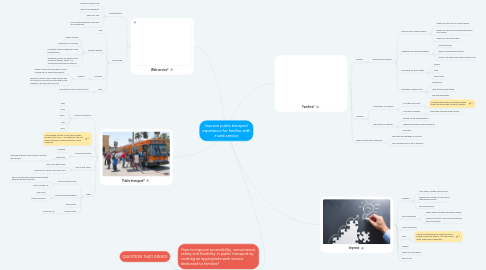
1. How to improve accessibility, convenience, safety and flexibility in public transport by creating an appropriate web service dedicated to families?
1.1. QUESTION THAT ARISES
2. Public transport?
2.1. Means of transport
2.1.1. Train
2.1.2. Tram
2.1.3. Metro
2.1.4. Bus
2.1.5. Ferry
2.2. “A developed country is not a place where the poor have cars — it’s where the rich use public transport.” Enrique Penalosa, mayor of Bogota
2.3. Several difficulties
2.3.1. crowded
2.3.2. expensive
2.3.2.1. travelling with kids often requires an extra fare be paid
2.4. How to use them?
2.4.1. Buy a one-hour ticket
2.4.2. Subscribe to a public transport card
2.5. Why?
2.5.1. environmental issues
2.5.1.1. help in reducing the overall environmental greenhouse gas emissions
2.5.1.2. won't use the car
2.5.2. improve personal health
2.5.2.1. walk more
2.5.2.2. physical activity
2.5.3. save money
2.5.4. quicker travel
2.5.4.1. allows you to
3. Web service?
3.1. Characteristics
3.1.1. Should be easy to use
3.1.2. work on smartphones
3.1.3. should be free
3.1.4. can be downloaded on AppStore and GooglePlay
3.2. Technology
3.2.1. App
3.2.2. Internet website
3.2.2.1. Transit-tracker
3.2.2.2. Distraction for children
3.2.2.3. Possibility to add a feedback of the transportation
3.2.2.4. Possibility to vote for what you will transport (stroller, wallet...) to provide the good size for the bus
3.2.3. AI/Robot
3.2.3.1. Chatbot
3.2.3.1.1. makes it easier to know when a bus is coming just by asking the chatbot
3.2.3.1.2. permits to keep an eye on the children and not spend too much time searching on the website to find the good bus line
3.2.4. data
3.2.4.1. use data to create a transport API
4. Families?
4.1. Parents
4.1.1. difficulties for parents
4.1.1.1. keep an eye on their children
4.1.1.1.1. make sure they don't do stupid things
4.1.1.1.2. make sure they aren't putting themselves into danger
4.1.1.1.3. make sure they are all here
4.1.1.2. gathering the children together
4.1.1.2.1. always moving
4.1.1.2.2. going on different directions
4.1.1.2.3. want to sit down when there's a place free
4.1.1.3. find place for bulky things
4.1.1.3.1. stroller
4.1.1.3.2. bags
4.1.1.3.3. baby stuffs
4.1.1.4. keep their children calm
4.1.1.4.1. impatience
4.1.1.4.2. want to touch everything
4.1.1.4.3. talk with everybody
4.2. Children
4.2.1. advantages for children
4.2.1.1. provides autonomy
4.2.1.1.1. "Children who grow up comfortable with transit are more likely to use it as adults"
4.2.1.2. provides sociability
4.2.1.2.1. make them talk with other people
4.2.2. difficulties for children
4.2.2.1. waiting for the transportation
4.2.2.2. understanding where they should go
4.2.2.3. Stay safe
4.3. What business they represent
4.3.1. important demographic for transit
4.3.2. often ignored part of the customers
5. Improve
5.1. Cheaper
5.1.1. offer family-friendly fare policies
5.1.2. permit small children to ride free or with reduced prices
5.1.3. sell family passes
5.2. More accessible
5.2.1. better transit marketing towards families
5.2.2. make sure transit is not an uncomfortable place for parents
5.3. More convenient
5.4. Safe
5.4.1. "Transit is statistically the safest mode for children below the ages of 13 in the United State, even when inadequate."
